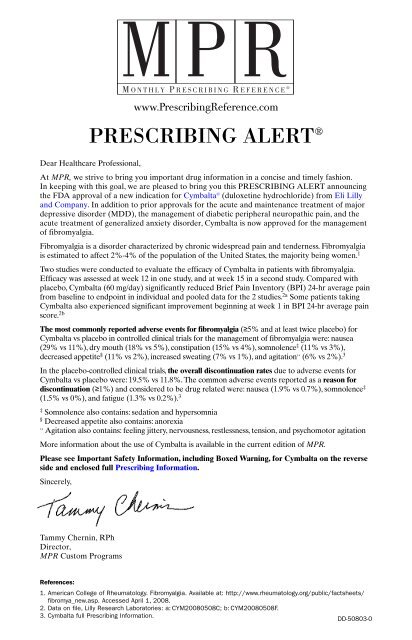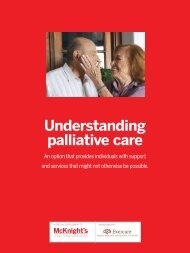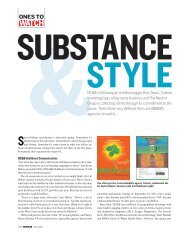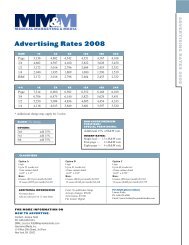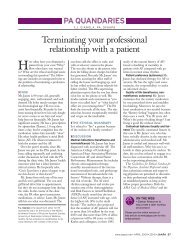Lunesta Letter - Haymarket Media Group
Lunesta Letter - Haymarket Media Group
Lunesta Letter - Haymarket Media Group
Create successful ePaper yourself
Turn your PDF publications into a flip-book with our unique Google optimized e-Paper software.
PRESCRIBING ALERT <br />
Dear Healthcare Professional,<br />
At MPR, we strive to bring you important drug information in a concise and timely fashion.<br />
In keeping with this goal, we are pleased to bring you this PRESCRIBING ALERT announcing<br />
the FDA approval of a new indication for Cymbalta ® (duloxetine hydrochloride) from Eli Lilly<br />
and Company. In addition to prior approvals for the acute and maintenance treatment of major<br />
depressive disorder (MDD), the management of diabetic peripheral neuropathic pain, and the<br />
acute treatment of generalized anxiety disorder, Cymbalta is now approved for the management<br />
of fibromyalgia.<br />
Fibromyalgia is a disorder characterized by chronic widespread pain and tenderness. Fibromyalgia<br />
is estimated to affect 2%-4% of the population of the United States, the majority being women. 1<br />
Two studies were conducted to evaluate the efficacy of Cymbalta in patients with fibromyalgia.<br />
Efficacy was assessed at week 12 in one study, and at week 15 in a second study. Compared with<br />
placebo, Cymbalta (60 mg/day) significantly reduced Brief Pain Inventory (BPI) 24-hr average pain<br />
from baseline to endpoint in individual and pooled data for the 2 studies. 2a Some patients taking<br />
Cymbalta also experienced significant improvement beginning at week 1 in BPI 24-hr average pain<br />
score. 2b<br />
The most commonly reported adverse events for fibromyalgia (≥5% and at least twice placebo) for<br />
Cymbalta vs placebo in controlled clinical trials for the management of fibromyalgia were: nausea<br />
(29% vs 11%), dry mouth (18% vs 5%), constipation (15% vs 4%), somnolence ‡ (11% vs 3%),<br />
decreased appetite § (11% vs 2%), increased sweating (7% vs 1%), and agitation ›› (6% vs 2%). 3<br />
In the placebo-controlled clinical trials, the overall discontinuation rates due to adverse events for<br />
Cymbalta vs placebo were: 19.5% vs 11.8%. The common adverse events reported as a reason for<br />
discontinuation (≥1%) and considered to be drug related were: nausea (1.9% vs 0.7%), somnolence ‡<br />
(1.5% vs 0%), and fatigue (1.3% vs 0.2%). 3<br />
‡ Somnolence also contains: sedation and hypersomnia<br />
§ Decreased appetite also contains: anorexia<br />
›› Agitation also contains: feeling jittery, nervousness, restlessness, tension, and psychomotor agitation<br />
More information about the use of Cymbalta is available in the current edition of MPR.<br />
Please see Important Safety Information, including Boxed Warning, for Cymbalta on the reverse<br />
side and enclosed full Prescribing Information.<br />
Sincerely,<br />
Tammy Chernin, RPh<br />
Director,<br />
MPR Custom Programs<br />
References:<br />
www.PrescribingReference.com<br />
1. American College of Rheumatology. Fibromyalgia. Available at: http://www.rheumatology.org/public/factsheets/<br />
fibromya_new.asp. Accessed April 1, 2008.<br />
2. Data on file, Lilly Research Laboratories: a: CYM20080508C; b: CYM20080508F.<br />
3. Cymbalta full Prescribing Information.<br />
DD-50803-0
Important Safety Information<br />
Cymbalta is indicated in adults for:<br />
• The acute and maintenance treatment of major depressive disorder (MDD)<br />
• The acute treatment of generalized anxiety disorder (GAD)<br />
• The management of diabetic peripheral neuropathic pain (DPNP)<br />
• The management of fibromyalgia (FM)<br />
Suicidality and Antidepressant Drugs—Antidepressants increased the risk compared to placebo of suicidal thinking and<br />
behavior (suicidality) in children, adolescents, and young adults in short-term studies of major depressive disorder (MDD)<br />
and other psychiatric disorders. Anyone considering the use of Cymbalta or any other antidepressant in a child, adolescent,<br />
or young adult must balance this risk with the clinical need. Short-term studies did not show an increase in the risk<br />
of suicidality with antidepressants compared to placebo in adults beyond age 24; there was a reduction in risk with antidepressants<br />
compared to placebo in adults aged 65 and older. Depression and certain other psychiatric disorders are themselves<br />
associated with increases in the risk of suicide. Patients of all ages who are started on antidepressant therapy should<br />
be monitored appropriately and observed closely for clinical worsening, suicidality, or unusual changes in behavior.<br />
Families and caregivers should be advised of the need for close observation and communication with the prescriber.<br />
Cymbalta is not approved for use in pediatric patients.<br />
Contraindications<br />
• Cymbalta should not be used in combination with MAOIs and is contraindicated for at least 14 days after discontinuation of an<br />
MAOI. After stopping therapy on Cymbalta, at least 5 days should be allowed before starting an MAOI.<br />
• Cymbalta was associated with an increased risk of mydriasis; therefore, it should not be used in patients with uncontrolled<br />
narrow-angle glaucoma and used cautiously in patients with controlled narrow-angle glaucoma.<br />
• Clinical Worsening and Suicide Risk<br />
All patients being treated with antidepressants for any indication should be monitored appropriately and observed closely for<br />
clinical worsening, suicidality, and unusual changes in behavior, especially within the first few months of treatment and when<br />
changing the dose. Consider changing the therapeutic regimen, including possibly discontinuing the medication in patients whose<br />
depression is persistently worse or includes symptoms of anxiety, agitation, panic attacks, insomnia, irritability, hostility, aggressiveness,<br />
impulsivity, akathisia (psychomotor restlessness), hypomania, mania, or suicidality that are severe, abrupt in onset, or<br />
were not part of the patient’s presenting symptoms. If discontinuing treatment, the medication should be tapered. Families and<br />
caregivers of patients being treated with antidepressants for any indication should be alerted about the need to monitor patients.<br />
• Hepatic failure, sometimes fatal, has been reported in patients treated with Cymbalta. Cymbalta should be discontinued in<br />
patients who develop jaundice or other evidence of clinically significant liver dysfunction and should not be resumed unless<br />
another cause can be established.<br />
• Because it is possible that Cymbalta and alcohol may interact to cause liver injury or that Cymbalta may aggravate preexisting<br />
liver disease, Cymbalta should ordinarily not be prescribed to patients with substantial alcohol use or evidence of<br />
chronic liver disease.<br />
• Orthostatic hypotension and syncope have been reported with therapeutic doses of Cymbalta. Consideration should be given to<br />
discontinuing Cymbalta in patients who experience symptomatic orthostatic hypotension and/or syncope.<br />
• Development of a potentially life-threatening serotonin syndrome may occur with SNRIs and SSRIs, including Cymbalta treatment,<br />
particularly with concomitant use of serotonergic drugs, including triptans. Concomitant use is not recommended.<br />
• SSRIs and SNRIs, including Cymbalta, may increase the risk of bleeding events. Patients should be cautioned about the risk of<br />
bleeding associated with concomitant use of Cymbalta and NSAIDs, aspirin, warfarin, or other drugs that affect coagulation.<br />
• On abrupt or tapered discontinuation, spontaneous reports of adverse events, some of which may be serious, have been<br />
reported during the marketing of SSRIs and SNRIs. A gradual reduction in dose rather than abrupt cessation is recommended<br />
when possible.<br />
• As with many antidepressants, Cymbalta should be used cautiously in patients with a history of mania or with a history of a<br />
seizure disorder.<br />
• In clinical trials across indications relative to placebo, treatment with Cymbalta was associated with mean increases of up to<br />
2.3 mm Hg systolic and diastolic blood pressure. There was no significant difference in the frequency of sustained (3 consecutive<br />
visits) elevated blood pressure. Blood pressure should be measured prior to initiating treatment and periodically measured<br />
throughout treatment.<br />
• Coadministration of Cymbalta with potent CYP1A2 inhibitors or thioridazine should be avoided.<br />
• SSRIs and SNRIs, including Cymbalta, have been associated with cases of clinically significant hyponatremia that appeared to<br />
be reversible when Cymbalta was discontinued. Elderly patients may be at greater risk of developing hyponatremia with SSRIs<br />
and SNRIs.<br />
• The effect that alterations in gastric motility may have on the stability of the enteric coating of Cymbalta is unknown. As duloxetine<br />
is rapidly hydrolyzed in acidic media to naphthol, caution is advised in using Cymbalta in patients with conditions that may<br />
slow gastric emptying (eg, some diabetics).<br />
• Cymbalta should ordinarily not be administered to patients with any hepatic insufficiency or patients with end-stage renal disease<br />
(requiring dialysis) or severe renal impairment (creatinine clearance
Cymbalta ® PRESCRIBING ALERT<br />
Delayed-Release Capsules<br />
(duloxetine HCI)<br />
Company: Eli Lilly and Company <br />
Pharmacologic class: Serotonin and<br />
norepinephrine reuptake inhibitor<br />
Indications: Management of fibromyalgia.<br />
Management of diabetic peripheral<br />
neuropathic pain (DPNP).Acute and<br />
maintenance treatment of major depressive<br />
disorder (MDD).Acute treatment of<br />
generalized anxiety disorder (GAD).<br />
Dosing: Fibromyalgia: 30-60 mg.*<br />
DPNP: 60 mg/day (once daily).<br />
MDD Acute: 40 mg/day (20 mg twice daily)<br />
to 60 mg/day (once daily or as 30 mg twice<br />
daily).<br />
MDD Maintenance: 60 mg/day.<br />
GAD Acute: 60 mg/day (once daily).<br />
Now approved for the<br />
management of fibromyalgia<br />
How supplied: Caps (20 mg,30 mg,<br />
60 mg)—100<br />
*Treatment should begin at 30 mg once daily for<br />
1 week, to allow patients to adjust to the medication<br />
before increasing to 60 mg once daily.<br />
In fibromyalgia, Cymbalta demonstrated significant and potent<br />
pain relief<br />
Cymbalta has demonstrated efficacy for patients with fibromyalgia<br />
CYMBALTA 60 MG/DAY IN FIBROMYALGIA CLINICAL TRIALS:<br />
1a †<br />
BPI 24-HOUR AVERAGE PAIN AT ENDPOINT<br />
Improvement<br />
% Change in Mean BPI 24-hour Average Pain<br />
Score Baseline to Endpoint<br />
100<br />
60<br />
50<br />
40<br />
30<br />
20<br />
10<br />
0<br />
*<br />
Cymbalta 60 mg/day (N=260)<br />
Placebo (N=257)<br />
2 pooled studies (LOCF)<br />
* P
Cymbalta provides rapid relief of fibromyalgia pain<br />
• Cymbalta provided rapid pain relief in patients with pain from fibromyalgia 1c<br />
• A statistically significant reduction in pain over placebo was seen as early as<br />
week 1 in fibromyalgia trials 1c<br />
Safety and tolerability<br />
Nausea<br />
Dry mouth<br />
Constipation<br />
Somnolence *<br />
Decreased appetite †<br />
Increased sweating<br />
Agitation ‡<br />
PRESCRIBING ALERT<br />
CYMBALTA 60 MG/DAY IN FIBROMYALGIA CLINICAL TRIALS:<br />
EFFECT ON BPI 24-HOUR AVERAGE PAIN SCORE 1c†<br />
Improvement<br />
% Change in Mean BPI 24-hour Average Pain Score<br />
0<br />
-5<br />
-10<br />
-15<br />
-20<br />
-25<br />
-30<br />
-35<br />
-40<br />
-45<br />
Weeks on Study Drug<br />
0 2 4 6 8 10 12<br />
*<br />
*<br />
*<br />
MOST COMMON ADVERSE EVENTS IN FIBROMYALGIA STUDIES 1d,2<br />
Cymbalta<br />
20-120 mg/day<br />
(N=876)<br />
(%)<br />
29<br />
18<br />
15<br />
11<br />
11<br />
7<br />
6<br />
*<br />
Placebo<br />
(N=535)<br />
(%)<br />
*<br />
Somnolence also contains: sedation and hypersomnia<br />
†<br />
Decreased appetite also contains: anorexia<br />
‡<br />
Agitation also contains: feeling jittery, nervousness, restlessness, tension, and psychomotor agitation<br />
Adverse events reported at a rate of ≥5% and at least twice the rate of placebo<br />
Data are from two 3-month and two 6-month placebo-controlled studies<br />
Overall discontinuation rate due to adverse events: Cymbalta (20-120 mg/day): 20% vs placebo: 12% 2<br />
Please see Important Safety Information, including Boxed Warning,<br />
for Cymbalta and enclosed full Prescribing Information.<br />
*<br />
*<br />
11<br />
5<br />
4<br />
3<br />
2<br />
1<br />
2<br />
*<br />
Cymbalta 60 mg/day (N=116)<br />
Placebo (N=118)<br />
One outpatient study (MMRM)<br />
* P≤.05, Cymbalta vs placebo<br />
In a separate study, % change in<br />
mean BPI 24-hour average pain<br />
score improvement was measured<br />
at weeks 1, 2, 4, 7, 11, and 151c – Cymbalta 60 mg/day was not<br />
significantly different vs placebo<br />
at weeks 7, 11, and 15<br />
† As measured by an 11-point<br />
Likert Scale<br />
Mean baseline score 6.41b BPI= Brief Pain Inventory<br />
MMRM=Mixed-effects Models<br />
Repeated Measures analysis<br />
% of patients on Cymbalta<br />
who discontinued due<br />
to treatment-emergent<br />
adverse events 1d<br />
1.9<br />
0.1<br />
0.3<br />
2.1<br />
0.1<br />
0.5<br />
0.7<br />
(continued on next page)
Important Safety Information<br />
PRESCRIBING ALERT<br />
Cymbalta is indicated in adults for:<br />
• The acute and maintenance treatment of major depressive disorder (MDD)<br />
• The acute treatment of generalized anxiety disorder (GAD)<br />
• The management of diabetic peripheral neuropathic pain (DPNP)<br />
• The management of fibromyalgia (FM)<br />
Suicidality and Antidepressant Drugs—Antidepressants increased the risk compared to<br />
placebo of suicidal thinking and behavior (suicidality) in children, adolescents, and young<br />
adults in short-term studies of major depressive disorder (MDD) and other psychiatric disorders.<br />
Anyone considering the use of Cymbalta or any other antidepressant in a child, adolescent,<br />
or young adult must balance this risk with the clinical need. Short-term studies did<br />
not show an increase in the risk of suicidality with antidepressants compared to placebo in<br />
adults beyond age 24; there was a reduction in risk with antidepressants compared to placebo<br />
in adults aged 65 and older. Depression and certain other psychiatric disorders are themselves<br />
associated with increases in the risk of suicide. Patients of all ages who are started on<br />
antidepressant therapy should be monitored appropriately and observed closely for clinical<br />
worsening, suicidality, or unusual changes in behavior. Families and caregivers should be<br />
advised of the need for close observation and communication with the prescriber. Cymbalta<br />
is not approved for use in pediatric patients.<br />
Contraindications<br />
• Cymbalta should not be used in combination with MAOIs and is contraindicated for at<br />
least 14 days after discontinuation of an MAOI. After stopping therapy on Cymbalta, at<br />
least 5 days should be allowed before starting an MAOI.<br />
• Cymbalta was associated with an increased risk of mydriasis; therefore, it should not be<br />
used in patients with uncontrolled narrow-angle glaucoma and used cautiously in<br />
patients with controlled narrow-angle glaucoma.<br />
• Clinical Worsening and Suicide Risk<br />
All patients being treated with antidepressants for any indication should be monitored<br />
appropriately and observed closely for clinical worsening, suicidality, and unusual<br />
changes in behavior, especially within the first few months of treatment and when changing<br />
the dose. Consider changing the therapeutic regimen, including possibly discontinuing<br />
the medication in patients whose depression is persistently worse or includes symptoms<br />
of anxiety, agitation, panic attacks, insomnia, irritability, hostility, aggressiveness,<br />
impulsivity, akathisia (psychomotor restlessness), hypomania, mania, or suicidality that<br />
are severe, abrupt in onset, or were not part of the patient’s presenting symptoms. If discontinuing<br />
treatment, the medication should be tapered. Families and caregivers of<br />
patients being treated with antidepressants for any indication should be alerted about<br />
the need to monitor patients.<br />
• Hepatic failure, sometimes fatal, has been reported in patients treated with Cymbalta.<br />
Cymbalta should be discontinued in patients who develop jaundice or other evidence of<br />
clinically significant liver dysfunction and should not be resumed unless another cause<br />
can be established.<br />
• Because it is possible that Cymbalta and alcohol may interact to cause liver injury or that<br />
Cymbalta may aggravate pre-existing liver disease, Cymbalta should ordinarily not be<br />
prescribed to patients with substantial alcohol use or evidence of chronic liver disease.<br />
• Orthostatic hypotension and syncope have been reported with therapeutic doses of<br />
Cymbalta. Consideration should be given to discontinuing Cymbalta in patients who<br />
experience symptomatic orthostatic hypotension and/or syncope.<br />
• Development of a potentially life-threatening serotonin syndrome may occur with<br />
SNRIs and SSRIs, including Cymbalta treatment, particularly with concomitant use of<br />
serotonergic drugs, including triptans. Concomitant use is not recommended.<br />
(continued on back)
PRESCRIBING ALERT<br />
• SSRIs and SNRIs, including Cymbalta, may increase the risk of bleeding events. Patients<br />
should be cautioned about the risk of bleeding associated with concomitant use of<br />
Cymbalta and NSAIDs, aspirin, warfarin, or other drugs that affect coagulation.<br />
• On abrupt or tapered discontinuation, spontaneous reports of adverse events, some of<br />
which may be serious, have been reported during the marketing of SSRIs and SNRIs. A<br />
gradual reduction in dose rather than abrupt cessation is recommended when possible.<br />
• As with many antidepressants, Cymbalta should be used cautiously in patients with a<br />
history of mania or with a history of a seizure disorder.<br />
• In clinical trials across indications relative to placebo, treatment with Cymbalta was associated<br />
with mean increases of up to 2.3 mm Hg systolic and diastolic blood pressure.<br />
There was no significant difference in the frequency of sustained (3 consecutive visits)<br />
elevated blood pressure. Blood pressure should be measured prior to initiating treatment<br />
and periodically measured throughout treatment.<br />
• Coadministration of Cymbalta with potent CYP1A2 inhibitors or thioridazine should be<br />
avoided.<br />
• SSRIs and SNRIs, including Cymbalta, have been associated with cases of clinically significant<br />
hyponatremia that appeared to be reversible when Cymbalta was discontinued.<br />
Elderly patients may be at greater risk of developing hyponatremia with SSRIs and SNRIs.<br />
• The effect that alterations in gastric motility may have on the stability of the enteric coating of<br />
Cymbalta is unknown.As duloxetine is rapidly hydrolyzed in acidic media to naphthol, caution<br />
is advised in using Cymbalta in patients with conditions that may slow gastric emptying<br />
(eg, some diabetics).<br />
• Cymbalta should ordinarily not be administered to patients with any hepatic insufficiency<br />
or patients with end-stage renal disease (requiring dialysis) or severe renal impairment<br />
(creatinine clearance


